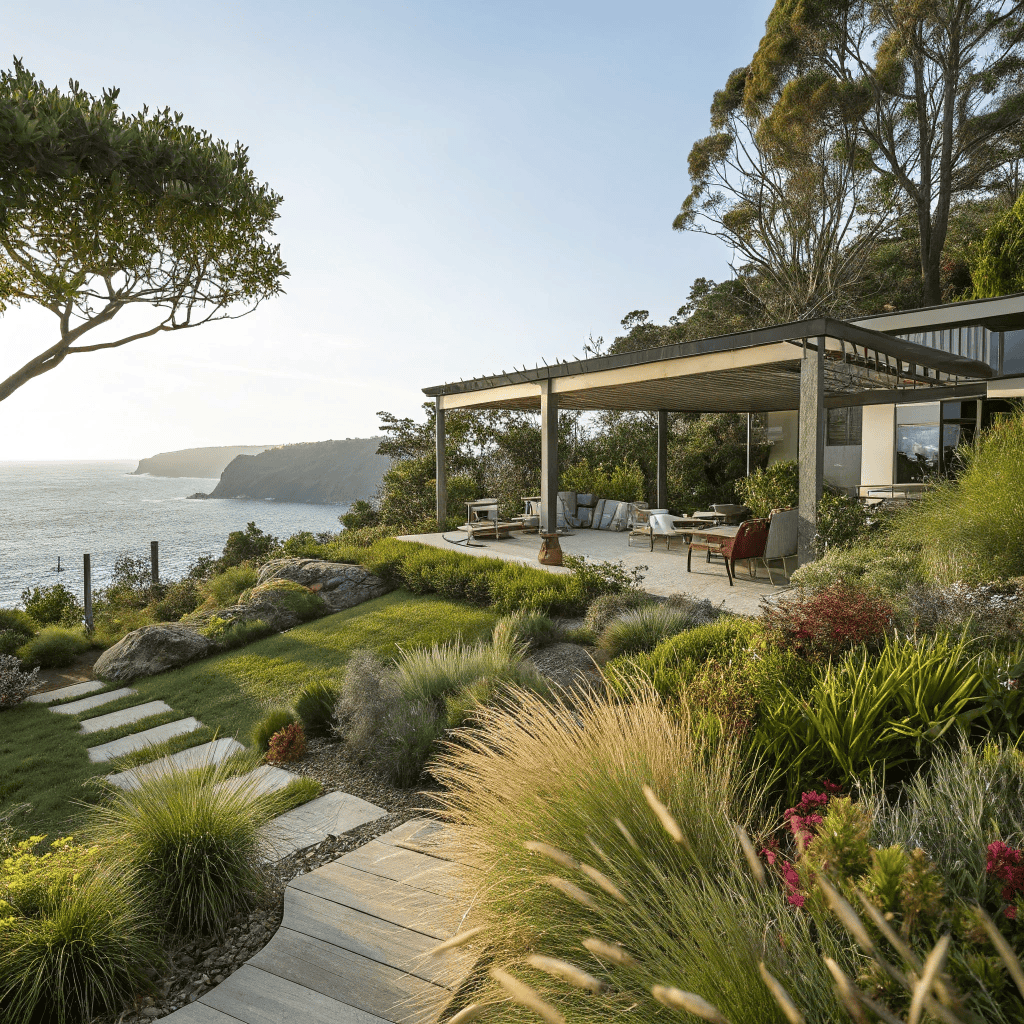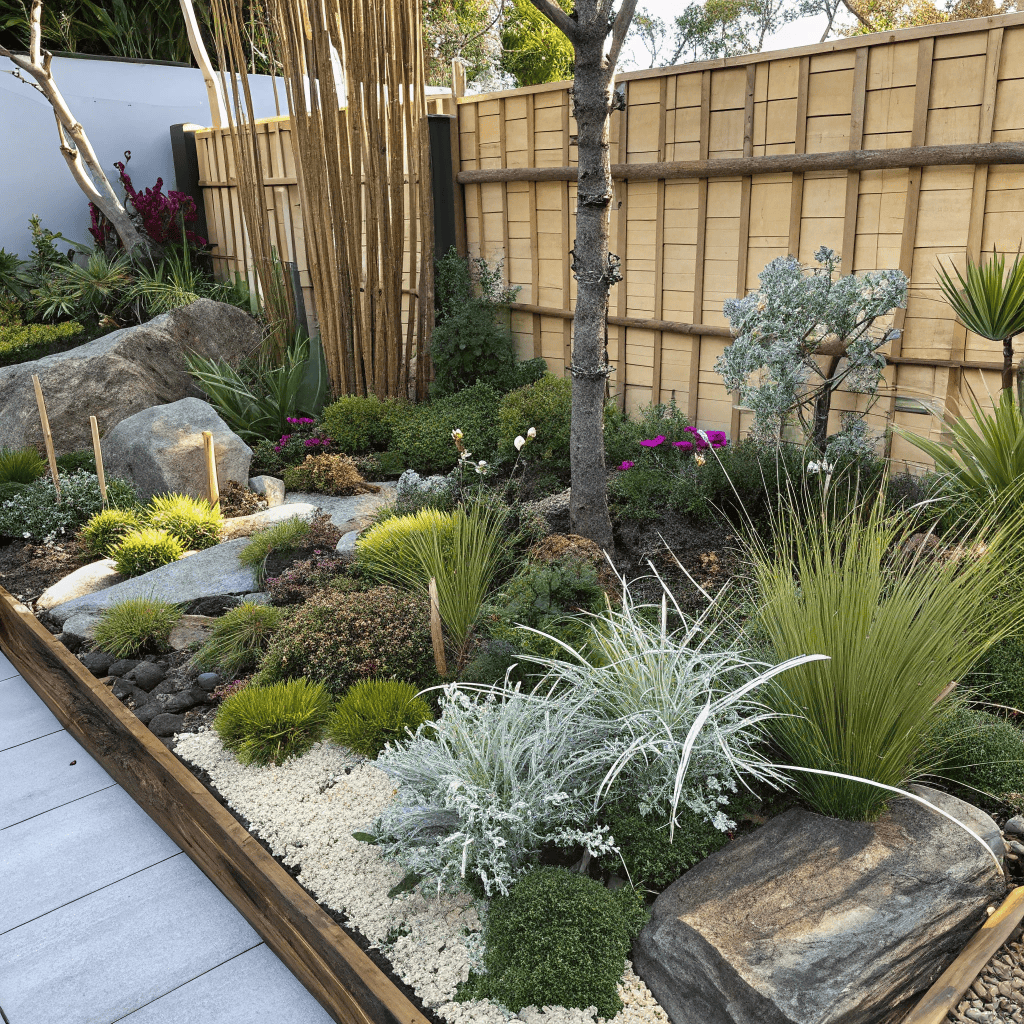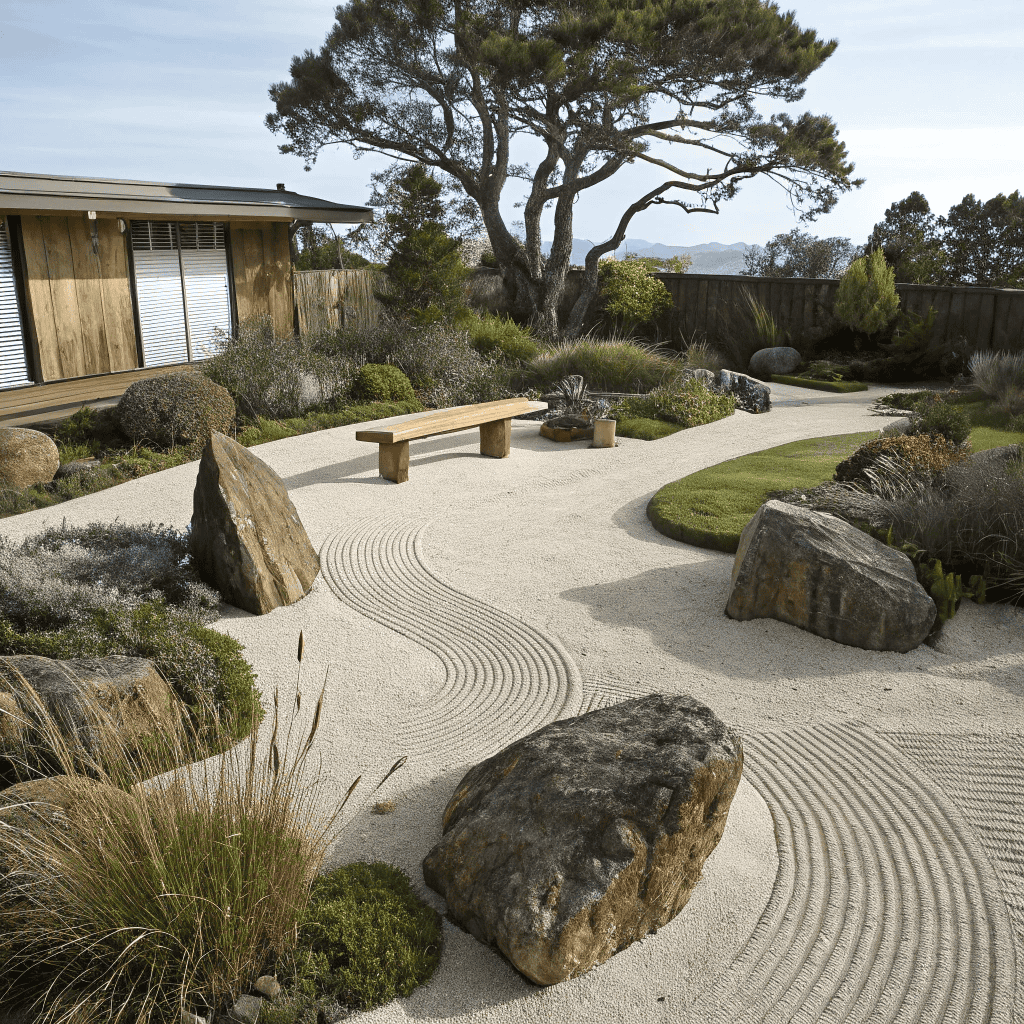Northern Beaches Best Local Landscapers
Japanese Garden Design Northern Beaches: Tranquil Zen Gardens Using Coastal Native Plants
The irony hits you every morning—living in one of Australia’s most beautiful coastal areas, yet feeling like your outdoor space adds stress instead of peace. Your garden battles salt air, your “Japanese” plants struggle against coastal winds, and what should be your sanctuary feels more like a maintenance burden.
But imagine stepping outside to find genuine tranquillity. Native banksias provide the same contemplative presence as traditional Japanese pines. Lomandra grasses offer bamboo’s graceful movement without invasive concerns. Stone pathways lead through carefully composed scenes that change with the seasons, all using plants that actually belong in our coastal climate.
Our Japanese garden design Northern Beaches service creates authentic zen spaces using native Australian plants that embody Japanese aesthetic principles while thriving in salt air and sandy soils. These aren’t struggling imitations—they’re inspired interpretations that honour both Japanese tradition and Northern Beaches environmental wisdom, providing daily meditation spaces that require minimal maintenance while offering maximum serenity for busy professionals seeking a peaceful retreat from demanding lifestyles.

Coastal Japanese Plant Palette
Structural Native Plants for Japanese Form
Creating an authentic Japanese garden structure requires plants with a strong architectural presence. Coastal banksia (Banksia integrifolia) provides a pine-like evergreen form with a distinctive coastal character. Lomandra longifolia offers bamboo’s vertical grace without invasive concerns. Melaleuca linariifolia delivers delicate foliage and elegant form, while Casuarina species provide needle-like texture and weeping habits perfect for Japanese aesthetic principles in salt air conditions.
Native Ground Covers for Japanese Carpet Effect
Japanese gardens depend on carpet-like ground coverage for visual cohesion and walking surfaces. Native violet (Viola hederacea) creates moss-like coverage in shaded areas where traditional moss struggles. Dichondra repens provides soft, walkable surfaces, while Selliera radicans offers dense coverage in moisture-retentive areas. Pigface (Carpobrotus glaucescens) delivers succulent texture for sunny dry zones, with native grasses providing textural variety throughout.
Seasonal Interest Plants for Japanese Garden Cycles
Temporal beauty drives Japanese garden appreciation—plants must change meaningfully through seasons. Acacia species provide spring flowering drama and delicate foliage shifts. Callistemon varieties offer seasonal blooming cycles while maintaining evergreen structure. Grevillea species deliver continuous flowering with varying seasonal intensity. Native iris provides architectural foliage with seasonal blooms, while coastal grasses create dramatic seed head displays and constant movement.
Specialised Japanese Garden Services
Zen Meditation Garden Design
Creating peaceful contemplation areas requires more than just arranging plants—it demands understanding how space, light, and natural elements work together to calm the mind. Our meditation gardens use native species and coastal materials to provide genuine respite from the Northern Beaches’ busy pace.
Meditation Elements:
- Karesansui (Dry Gardens): Raked gravel patterns using local coastal stones with strategic native plantings that invite contemplation without demanding attention
- Meditation Pavilions: Simple timber structures integrated with screening natives like Melaleuca linariifolia for private reflection spaces
- Walking Meditation Paths: Sandstone pathways winding through native gardens designed for mindful movement and seasonal appreciation
- Viewing Gardens: Carefully composed scenes using structural natives that reveal different beauty through morning light, afternoon shadows, and seasonal changes
- Tea Garden Spaces: Intimate areas scaled for quiet ceremony, using native ground covers and screening plants that provide appropriate enclosure
Native Japanese Plant Alternatives
The secret to authentic Japanese aesthetics isn’t forcing overseas species to survive our climate—it’s finding native plants that naturally embody Japanese design principles of form, texture, and seasonal interest.
Native Japanese Equivalents:
- Native Bamboo Alternative: Lomandra longifolia provides identical vertical lines and graceful movement without spreading concerns or maintenance headaches
- Native Maple Substitute: Acacia species offering delicate foliage and subtle seasonal colour changes that capture the Japanese garden’s temporal beauty
- Native Pine Alternative: Coastal banksia (Banksia integrifolia), providing an evergreen structure with a distinctive form that’s even more interesting than traditional pines
- Native Moss Equivalent: Viola hederacea and other indigenous ground covers create a carpet-like coverage in shaded areas where traditional moss would struggle
- Native Fern Gardens: Indigenous coastal ferns like Pteris tremula create authentic Japanese woodland aesthetics while handling salt air exposure
Water Feature Japanese Design
Water transforms Japanese gardens from pretty landscapes into spaces that actively calm your nervous system. The sound of moving water, the play of light on still surfaces, the way aquatic plants change through seasons—these elements create the meditative quality that makes Japanese gardens genuinely restorative.
Water Elements:
- Tsukubai (Water Basins): Hand-carved local sandstone basins surrounded by native violets and coastal grasses, creating purification spaces that handle salt air beautifully
- Koi Pond Alternatives: Natural swimming holes using native rush species and local stone, supporting native fish that don’t require heated water or complex filtration
- Stream Gardens: Meandering water courses using indigenous marginal plants like Juncus kraussii that provide authentic Japanese stream aesthetics while managing coastal stormwater
- Waterfall Features: Layered sandstone falls integrated with native ferns and grasses, designed to sound beautiful while handling the Northern Beaches’ variable rainfall
- Rain Gardens: Japanese-inspired water collection features using native sedges that turn stormwater management into contemplative seasonal displays
Contemporary Japanese Coastal Fusion
Traditional Japanese principles don’t have to mean old-fashioned aesthetics. Our contemporary interpretations blend ancient wisdom with modern Northern Beaches living, creating spaces that feel both timeless and perfectly suited to coastal entertaining lifestyles.
Contemporary Elements:
- Minimalist Zen Courtyards: Clean-lined spaces using architectural natives like Lomandra and Dianella arranged in geometric patterns that complement modern homes
- Outdoor Room Integration: Japanese spatial principles applied to entertainment areas, using native screening and structural plants to create intimate dining and relaxation zones
- Rooftop Zen Gardens: Containerised Japanese gardens using wind-tolerant natives, perfect for apartment terraces and townhouse rooftops
- Pool Integration: Swimming areas are designed with Japanese restraint using native plantings and natural materials that make pools feel like natural water features
- Modern Materials: Steel planters, concrete benches, and glass screens combined with natives arranged according to Japanese composition principles

Call Us Today on (02) 9538 7844
Japanese Garden Styles Adapted
Zen Dry Garden (Karesansui) with Coastal Elements
Traditional raked gravel gardens adapt beautifully to coastal conditions using local materials and strategic native plantings. Coastal sandstone and beach stones arranged in contemplative patterns create meditation focal points. Drought-tolerant natives like pigface and coastal grasses provide textural islands within raked areas.
Tea Garden (Roji) with Native Plants
Intimate tea garden pathways honour ceremony traditions using native species and local materials. Sandstone stepping stones wind between native violet ground covers and screening melaleucas. Native aquatic plants surround purification water features, while indigenous screening provides appropriate enclosure. Seasonal natives offer contemplative beauty for tea ceremony appreciation, with plant arrangements creating an intimate scale perfect for quiet reflection and traditional practices.
Contemporary Zen Courtyard Design
Modern Japanese courtyard interpretation blends traditional principles with contemporary Northern Beaches lifestyle needs. Minimalist native plantings arranged in clean geometric patterns complement modern architecture. Contemporary water features integrate native aquatics with steel and concrete elements. Subtle lighting highlights plant forms and design elements, while seamless indoor-outdoor flow connects interior spaces with native Japanese-style gardens through thoughtful material and plant selection.
Japanese Design Principles Adapted
Wabi-Sabi with Native Plants
Wabi-sabi celebrates imperfect beauty—weathered timber developing character, native grasses bending in coastal winds, patina forming on local stone. This aesthetic suits Northern Beaches conditions perfectly.
Wabi-Sabi Elements:
- Natural Aging: Banksia bark becoming sculptural, coastal stone developing lichen patterns
- Imperfect Harmony: Asymmetrical arrangements reflecting natural coastal growth
- Seasonal Transience: Native flowering cycles demonstrating beauty in change
- Weathered Materials: Local materials developing character through exposure
- Simple Elegance: Restrained palettes using subtle natives
Ma (Negative Space) in Coastal Gardens
Japanese gardens succeed through conscious empty space. Ma creates breathing room that lets your mind rest and notice the surrounding beauty.
Spatial Design:
- Breathing Room: Strategic placement creating contemplative pauses between elements
- View Framing: Natives positioned to focus attention on garden moments
- Transition Spaces: Subtle changes between areas defined by natural materials
- Seasonal Revelation: Arrangements revealing different aspects through seasonal changes
- Contemplative Voids: Empty spaces allowing the mind to rest while appreciating beauty
Borrowed Scenery (Shakkei)
Shakkei integrates distant views into garden composition, making spaces feel larger while connecting to the broader coastal landscape.
View Integration:
- Ocean Views: Frame beach vistas using native foreground plantings
- Headland Integration: Include distant views as composed background elements
- Sky Framing: Tree canopies positioned to frame changing conditions
- Seasonal Distant Views: Arrangements enhancing appreciation of landscape changes
- Natural Backdrop: Natives complementing Northern Beaches’ existing beauty
Japanese Garden Investment and Maintenance
Japanese Garden Investment Understanding
Creating authentic Japanese aesthetics using native plants and quality materials requires thoughtful investment planning. Native plant selections reduce ongoing maintenance costs by 30-50% compared to traditional Japanese species struggling in coastal conditions.
Investment Ranges:
- Zen Meditation Corner: $8,000-$15,000 for intimate Japanese garden spaces using native plants
- Courtyard Japanese Garden: $15,000-$35,000 for complete courtyard transformation with water features
- Estate Japanese Garden: $35,000-$75,000+ for a comprehensive Japanese landscape using native plants and stone work
- Maintenance Considerations: 30-50% lower ongoing costs using native plants versus traditional Japanese species
Long-Term Japanese Garden Value
Japanese garden design provides exceptional long-term value through timeless aesthetics and measurable wellness benefits. Contemplative spaces offer quantified stress reduction and mental health improvements for busy professionals. Distinctive design creates unique property positioning in the competitive Northern Beaches market. Japanese principles never date, ensuring lasting appeal, while native plant selections dramatically reduce ongoing care requirements. Daily access to peaceful, meditative spaces provides immeasurable spiritual value.
Japanese Garden Water Features
Natural Pool Design with Native Aquatics
Swimming pools designed with Japanese restraint blend seamlessly with native landscaping using natural materials and indigenous plantings. Natural edge pools integrate with native Japanese-style gardens through local stone work and careful plant selection. Native aquatic species handle pool proximity while maintaining authentic aesthetics. Privacy screening using coastal natives creates an appropriate garden enclosure, while adjacent meditation areas provide quiet contemplation spaces surrounded by thoughtfully arranged indigenous plantings.
Rain Garden Japanese Design
Stormwater management transforms into contemplative features using Japanese design principles and native plants perfectly suited to coastal rainfall patterns. Natural stream beds handle drainage while providing year-round beauty through indigenous marginal plants like native rush species. Stone bridge elements allow garden appreciation during varying water levels. Seasonal displays look stunning during both rain events and dry periods, while native plant selections attract beneficial wildlife.

Seasonal Japanese Garden Management
Four Season Japanese Garden Beauty
Japanese gardens provide year-round contemplative beauty through thoughtful design and native plant selection suited to coastal seasonal rhythms. Spring brings native plant emergence and early flowering for renewal contemplation. Summer delivers full foliage development, requiring minimal intervention and maintenance. Autumn offers subtle seasonal changes and preparation for quiet winter appreciation periods. Winter reveals structural beauty and provides contemplative spaces when traditional gardens look barren.
Minimal Intervention Maintenance
Japanese garden care maintains aesthetic principles while respecting native plant natural growth patterns through thoughtful, meditative approaches. Respectful pruning enhances natural forms while maintaining Japanese principles. Materials and plants develop character through natural weather exposure and time. Garden care follows natural cycles rather than imposed maintenance schedules, treating maintenance as a meditation practice. Understanding native growth patterns allows working with rather than against plant nature.

Quality Assurance and Authenticity
Japanese Garden Expertise
Authentic Japanese garden design using native plants requires specialised knowledge combining traditional philosophy with coastal environmental understanding. A deep understanding of Japanese design principles guides spatial relationships and compositional decisions. Expertise in native plant selection identifies species that naturally embody Japanese characteristics while thriving in salt air. Knowledge of local materials ensures authentic aesthetics using sandstone, timber, and coastal elements. Cultural sensitivity respectfully interprets traditions while adapting to local conditions.
Frequently Asked Questions
Japanese gardens require three fundamental elements: water (or its representation through gravel), stone for structure and permanence, and plants for seasonal beauty. In Northern Beaches gardens, we adapt these using coastal stone, native water features or dry stream beds, and indigenous plants that provide authentic Japanese aesthetics while thriving in salt air conditions.
Australian Japanese gardens succeed by selecting natives that embody Japanese principles rather than forcing overseas species to survive. Use Lomandra longifolia for bamboo effects, coastal banksia for pine-like structure, and native violets for moss-like ground coverage. Focus on form, texture, and seasonal interest rather than specific species.
Local coastal materials create authentic dry gardens suited to our environment. Use decomposed granite or crushed sandstone in neutral tones that complement beach surroundings. Avoid imported gravels that look foreign to coastal settings. Local stone develops beautiful patina and integrates naturally with surrounding native plantings.
Absolutely. Authentic Japanese gardens focus on design principles—asymmetrical balance, seasonal change, and contemplative spaces—rather than specific plant species. Native Australian plants often embody these principles more naturally than struggling imported species, creating gardens that are both authentically Japanese in spirit and genuinely Australian in character.
Native Japanese gardens require significantly less maintenance than traditional designs. Once established, native plants handle coastal conditions naturally, reducing watering, pest control, and replacement needs by 30-50%. Maintenance becomes meditative rather than demanding—light pruning, seasonal cleanup, and contemplative garden appreciation.
Zen gardens are minimalist meditation spaces focusing on contemplation through simplified elements like raked gravel and carefully placed stones. Japanese gardens encompass broader styles, including tea gardens, stroll gardens, and courtyard designs. Both can be created successfully using native plants that provide appropriate aesthetics for Northern Beaches conditions.
Create Your Tranquil Japanese Garden Sanctuary
Your peaceful retreat awaits—a contemplative space where ancient Japanese wisdom meets Northern Beaches coastal beauty. Stop battling against your environment and start working with it to create something extraordinary.
Ready to begin your zen transformation?
Book Your Free Japanese Garden Design Consultation – Discover how Japanese principles can transform your outdoor space using stunning native plants that thrive in coastal conditions.
Schedule Your Property Assessment – Let us evaluate your space and recommend the perfect Japanese garden elements for your Northern Beaches lifestyle.
Create a tranquil Japanese garden sanctuary that provides daily respite and contemplation using beautiful native plants perfectly adapted to Northern Beaches coastal conditions while honouring authentic Japanese design principles that enhance your spiritual well-being and property value.




